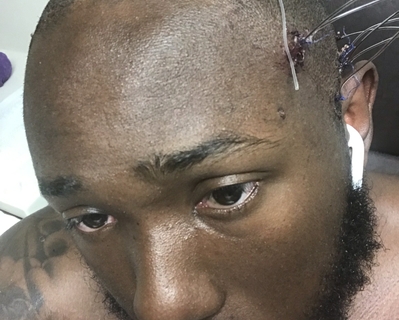Donniven Sackiel was 26 when he walked into a hospital as a patient for the first time in his life.
He hated hospitals. But Sackiel knew the visit to Novant Health Presbyterian Medical Center in September 2021 was long overdue. He wanted to be the strongest dad possible for his son, Donniven Jr., and that meant finally confronting the epileptic seizures that had been affecting him his entire adult life.
Sackiel would zone out, drool and bite his tongue uncontrollably during what started as occasional focal seizures, which were characterized by brief episodes of muscle spasms and losing awareness. Sackiel experienced his first about a year after he graduated from high school, when his mom witnessed a seizure while he slept. He was later diagnosed with epilepsy, a brain disorder affecting more than 3 million people in the U.S.
Personalized treatment for epilepsy and seizures
For a while he stocked shelves at Walmart overnight, a shift that ensured no customers would ever witness an episode. But his co-workers did. His toddler son had, too. The stress of it all triggered more seizures. Sackiel went on work disability and put off college plans.
“I had all these opportunities ahead of me,” Sackiel said. “And I’m thinking, ‘My life is over.’”
Doctors’ goal: ‘Make a big impact’
There are many seizure types associated with epilepsy. In some cases a stroke or traumatic brain injury can cause them, though for about half of people affected, epilepsy causes are unknown.
Different anti-seizure medications failed to control Sackiel’s episodes. Because of this his doctors explained that surgery, combined with the right medicine, could lead to the most hopeful outcome: seizure freedom. That’s a term for no longer experiencing them.

Brain surgery does not guarantee an end to seizures. But it is effective in about 70% of people with treatment-resistant epilepsy, according to the American Academy of Neurology. Because the medicine alone wasn’t working, Sackiel was an ideal candidate for surgery, said Dr. Neil Patel, director of epilepsy of the greater Novant Health Charlotte region. He treats patients at Novant Health Neurology & Sleep - Midtown.
“As we slowly realize the limitations of modern pills, it’s opening the door to further options in treatment via surgery,” Patel said. “The goal is to make a big impact on patients’ lives who are on five or six meds and still not achieving seizure freedom.”
There is no cure for epilepsy. But Sackiel realized he could have the next best thing after meeting with Patel and surgeon Dr. Charles Munyon, of Novant Health Brain & Spine Surgery - Cotswold.
“They are two great people,” Sackiel said. “They told me the negatives and the positives of surgery, and that’s what made me decide to really want to do it. I truly had to believe in myself, though.”
Advancements in surgery
Munyon performed stereoelectroencephalography (SEEG) electrode implantation on Sackiel. In the procedure, the surgeon drills tiny holes into the skull and implants electrodes in the brain. This way, the precise spread of Sackiel’s seizures could be mapped and treated by removing about 2 inches of tissue without causing damage to other functions of the brain.
This “minimally invasive” approach has advanced over the last 20 years, Munyon said. Surgery used to be much more invasive, with doctors removing a piece of the skull to implant electrodes to map seizures.
Munyon discussed with Sackiel that open surgery was more advantageous than laser ablation (using a laser to burn tissue), a treatment with a slightly higher risk of seizure recurrence in Sackiel’s case. Plus, patients are able to leave the hospital the next day. That was music to Sackiel’s ears.
He went home and hasn’t experienced a seizure since.
No cure, but control
While there is no cure for epilepsy, the right combination of medicine and surgery can succeed in reducing or ending seizures.
“Neurology can be really tough to treat or cure many conditions, but epilepsy is one small subset where we feel we stand a chance to do so,” Patel said.

Following surgery, patients are weaned off their seizure medication and monitored.
“Unfortunately, it’s not the kind of thing where we do the surgery and then say, ‘OK, you're cured,’” Munyon said. “It’s much more a question of long-term follow-up.”
Two years after surgery, Sackiel is seizure-free and down from multiple anti-seizure pills to a limited dose of levetiracetam. He remains on disability because of the medication but is able to drive a car and carry on with daily life without the anxiety that accompanied years of seizures.
“The opportunities now are endless,” said Sackiel, who is thinking about pursuing college. “I’m not restricted to a specific boundary because of any medical reason. I can truly do anything I want.”










